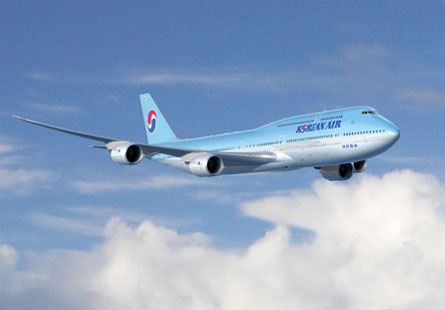An order by Korean Air for five Boeing 747-8 Intercontinental snaps a nearly three year dry spell for the passenger-configured jumbo, and could signal the start of a slow climb for large airplane purchases in the coming years.
Boeing last received an order for the 747-8 Intercontinental from Lufthansa on 6 December 2006, when the company's latest iteration of the venerable 747 was first launched.
Korean's purchase of the 747-8I follows a similar trend by Lufthansa, who has also purchased the A380, and plans to use the 747 as a capacity gap filler between its 300 and 550-seat aircraft. Korean Air has also placed ten firm orders for the A380.
 |
|---|
© Boeing |
But even with today's order and recent purchases of A380 by airlines like Air Austral for two, and a letter intent signed by Vietnam for four, the large aircraft market remains a niche for Airbus and Boeing because of potential market volatility, says one analyst.
"Operating large aircraft can be very dangerous when the market tanks," says vice president of analysis for the Teal Group, Richard Aboulafia. "But the Korean order shows that the 747-8I still will have part of this niche, despite some very aggressive A380 pricing."
Boeing's large aircraft segement has been dominated by orders from the 777-300ER configured with more than 365 seats, which has acted as a replacement to older 747s.
For example, carriers like Singapore Airlines, All Nippon Airways and Air New Zealand have replaced the four-engine jet with the twin-engine 777-300ER, opting to maintain the size of premium cabins, while reducing economy class seating.
Aboulafia adds that Boeing and Airbus widebody backlogs are dominated by future orders for their respective long-range high-capacity twin-engine jetliners.
"The big plane market has been all but obliterated by the huge popularity of the long-range mini-jumbos, especially the 777-300ER and A350 XWB," adds Aboulafia.
"As the saying goes, nobody ever went bankrupt flying planes that were too small. Very few carriers will replace 747-400s with equally large or larger planes. There's just too much to be said for getting rid of 20% of your lowest yield passengers and focusing on improving profits. You also get greater schedule and route flexibility with smaller long-range planes," says Aboulafia.
Boeing estimates 740 large passenger aircraft over the next twenty years, a forecast that was slashed by almost 25%, down from 980 large aircraft. Of those 740, Boeing believes just over 500 will be passenger aircraft.
"That means a handful of [747 v. A380] campaigns moving forward, all those campaigns are going to be tough. I like to say, lots of hand to hand combat," said Randy Tinseth, vice president of marketing for Boeing at the Dubai air show, before the Korean order was announced.
Tinseth conceded at the show that "it's a really tough market to be selling big airplanes."
Though he added that the 747-8 family has been "selling in total about where we expected, we've been very pleased with the strength of the freighter, we're dissapointed that we haven't sold more passenger airplanes."
Boeing holds orders for 110 747-8 aircraft, split between 78 freighters, 7 VIPs and 25 configured for airline use.
Tinseth believes that the large airplane market will rebound when the economy begins to improve.
"Ultimately we believe that market is going to pick up when airlines...this coming cycle...start to replace their older 747s."
A recent report by 7SEAS Aviation consultancy showed that one in ten 747-400s is now in storage, a number expected to grow as older aircraft are retired.
Boeing offers the 747-8I, a 5.6m stretch over the existing 747-400, in VIP and airline configured variants. Entry into service is expected in the fourth quarter of 2011.
Boeing announced 3 December that it had passed the 90% design release mark on the new -8I aircraft.
Source: Air Transport Intelligence news























